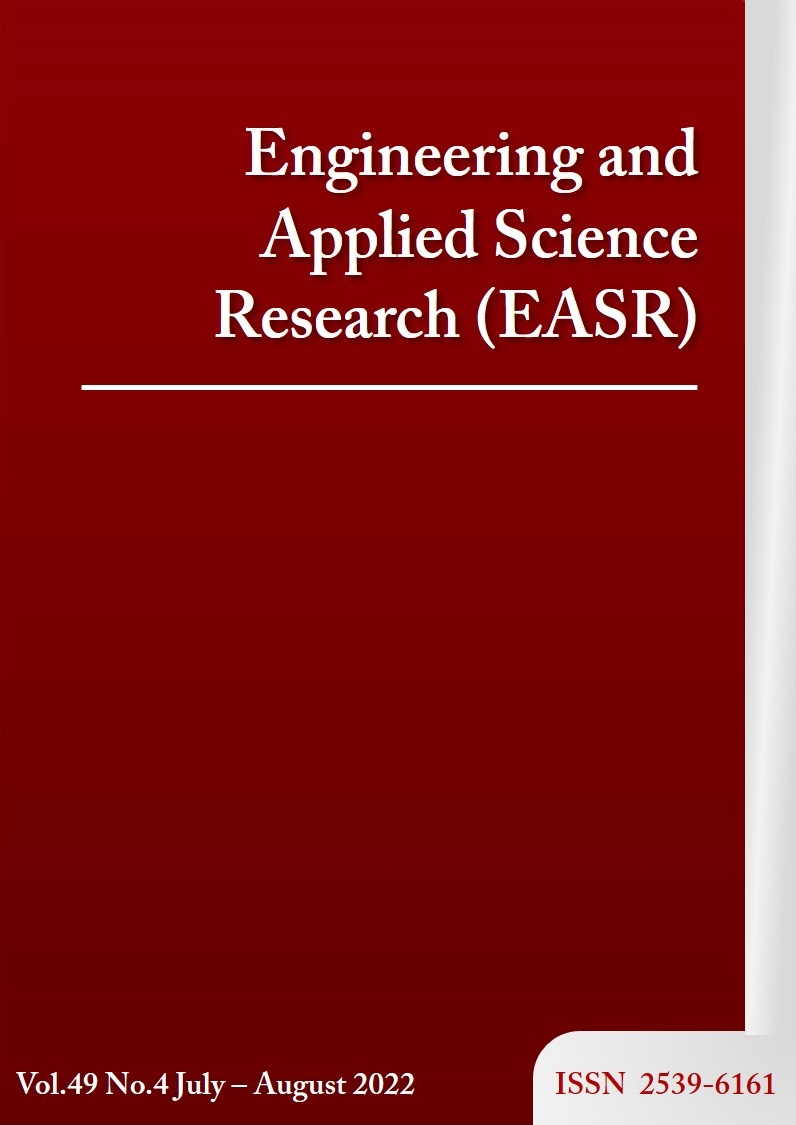Evaluation of informative spectral wavelengths for estimating soluble solids content in sugarcane billets
Main Article Content
Abstract
This study proposed individual spectral wavelengths significant to estimate soluble solids content (SSC) in sugarcane billets moving on the conveyor. At the same time, an all-in-one quality and yield monitor using those wavelengths for a sugarcane harvester was also proposed. Seven wavelengths, 475, 560, 668, 717, 755, 840, and 890 nm, were arranged into three groups for modeling. Group 1, consisting of 475, 560, 668, 717, and 840 nm, was based on the spectral responses of a commercial multispectral camera, while group 2 (717 and 840 nm) was based on the invisible (RedEdge and near-infrared or NIR) responses of the camera. For group 3, two sugar-related wavelengths at 755 and 890 nm were selected as the candidates for modeling. Partial least squares regression (PLSR) was employed to model those three groups with corresponding soluble solids content (SSC). The results showed that the developed models based on two sugar-related wavelengths at 755 and 890 nm provided the best performance, explaining 80.2 % of the variance in the SSC and displaying a root mean square error of calibration (RMSEC) of 0.32 ºBrix. The predictive performance had the root mean square error of prediction (RMSEP) of 0.33 ºBrix. This finding confirmed the effectiveness of the sugar wavelengths and conveyed the possibility to develop the sugarcane quality and yield monitor.
Article Details

This work is licensed under a Creative Commons Attribution-NonCommercial-NoDerivatives 4.0 International License.
This work is licensed under a Creative Commons Attribution-NonCommercial-NoDerivatives 4.0 International License.
References
Bramley RGV. Lessons from nearly 20 years of precision agricultural research, development, and adoption as a guide to its appropriate application. Crop Pasture Sci. 2009;60(3):197-217.
Nawi NM, Chen G, Jensen T. Visible and shortwave near infrared spectroscopy for predicting sugar content of sugarcane based on a cross-sectional scanning method. J Near Infrared Spectrosc. 2013;21(4):289-97.
McCarthy S, Billingsley J. A sensor for the sugar cane harvester topper. Sens Rev. 2002;22(3):242-6.
Klute U. Microwave measuring technology for the sugar industry. Int Sugar J. 2007;109(1308):749-55.
Nelson SO. Potential agricultural applications for RF and microwave energy. Trans ASABE. 1987;30(3):818-31.
Shah S, Joshi M. Modeling microwave drying kinetics of sugarcane bagasse. Int J Electr Eng. 2010;2(1):159-63.
Nawi NM, Chen G, Jensen T, Mehdizadeh SA. Prediction and classification of sugar content of sugarcane based on skin scanning using visible and shortwave near infrared. Biosyst Eng. 2013;115(2):154-61.
Nawi NM, Chen G, Jensen T. In-field measurement and sampling technologies for monitoring quality in the sugarcane industry: a review. Precision Agric. 2014;15:684-703.
Phetpan K, Udompetaikul V, Sirisomboon P. An online visible and near-infrared spectroscopic technique for the real-time evaluation of the soluble solids content of sugarcane billets on an elevator conveyor. Comput Electron Agric. 2018;154:460-6.
Price RR, Johnson RM, Viator RP, Larsen J, Peters A. Fiber optic yield monitor for a sugarcane harvester. Trans ASABE. 2011;54(1):31-9.
Sugiyama J. Visualization of sugar content in the flesh of a melon by near-infrared imaging. J Agric Food Chem. 1999;47(7):2715-8.
Xu H, Qi B, Sun T, Fu X, Ying Y. Variable selection in visible and near-infrared spectra: application to on-line determination of sugar content in pears. J Food Eng. 2012;109(1):142-7.
Wang A, Xie L. Technology using near infrared spectroscopic and multivariate analysis to determine the soluble solids content of citrus fruit. J Food Eng. 2014;143:17-24.
Liu R, Qi S, Lu J, Han D. Measurement of soluble solids content of three fruit species using universal near infrared spectroscopy models. J Near Infrared Spectrosc. 2015;23(5):301-9.
Phuphaphud A, Saengprachatanarug K, Posom J, Maraphum K, Taira E. Prediction of the fibre content of sugarcane stalk by direct scanning using visible-shortwave near infrared spectroscopy. Vib Spectrosc. 2019;101:71-80.
Udompetaikul V, Phetpan K, Sirisomboon P. Development of the partial least-squares model to determine the soluble solids content of sugarcane billets on an elevator conveyor. Measurement. 2021;167:107898.
Varmuza K, Filzmoser P. Introduction to multivariate statistical analysis in chemometrics. Boca Raton: CRC Press; 2009.
Abdi H. Partial Least Squares (PLS) regression. In: Lewis-Beck M, Bryman A, Futing T, editors. Encyclopedia of social sciences research methods. Thousand Oaks: SAGE; 2003.
Miller JN, Miller JC. Statistics and chemometrics for analytical chemistry. 6th ed. Hoboken: Prentice Hall; 2010.
Osborne BG, Fearn T, Hindle PT. Practical NIR spectroscopy with applications in food and beverage analysis. 2nd ed. UK: Longman Scientific and Technical; 1993.
Golic M, Walsh K, Lawson P. Short-wavelength near-infrared spectra of sucrose, glucose, and fructose with respect to sugar concentration and temperature. Appl Spectrosc. 2003;57(2):139-45.
Guo Z, Huang W, Peng Y, Chen Q, Ouyang Q, Zhao J. Color compensation and comparison of shortwave near infrared and long wave near infrared spectroscopy for determination of soluble solids content of Fuji apple. Postharvest Biol Technol. 2016;115:81-90.
Travers S, Bertelsen MG, Petersen KK, Kucheryavskiy SV. Predicting pear (cv. Clara Frijs) dry matter and soluble solids content with near infrared spectroscopy. LWT-Food Sci Technol. 2014;59(2):1107-13.



